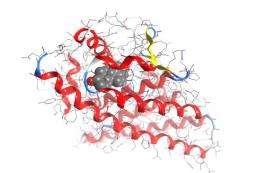Supercomputing research opens doors for drug discovery

A quicker and cheaper technique to scan molecular databases developed at the Department of Energy's Oak Ridge National Laboratory could put scientists on the fast track to developing new drug treatments.
A team led by Jerome Baudry of the University of Tennessee-ORNL Center for Molecular Biophysics adapted a widely used existing software to allow supercomputers such as ORNL's Jaguar to sift through immense molecular databases and pinpoint chemical compounds as potential drug candidates.
The research was published in the Journal of Computational Chemistry as "Task-parallel MPI implementation of Autodock4 for docking of very large databases of compounds using High Performance Super-Computers."
"Our research is the missing link between supercomputers and the huge data available in molecular databases like the Human Genome Project," Baudry said. "We have an avalanche of data available to us, and now we need to translate that data into knowledge."
Such translation is critical for the first stages of drug development, in which researchers look for appropriate chemicals that interact with a target in the body, typically a protein. If the chemical is suitable, it attaches onto the protein and produces a desirable effect in the cell.
But with thousands of known proteins and millions of chemicals as potential drugs, the number of possible combinations is astronomical.
"It is very expensive and time-consuming to measure these interactions experimentally," Baudry said. "But with supercomputers, we can process millions of molecules a day."
The quick and efficient processing of molecules offers scientists an opportunity to take risks on previously unexamined drug candidates, which could lead to diverse and innovative classes of drugs.
"Before, we threw away a lot of information because molecules did not have a preferred profile," Baudry said. "Now, every molecule can be examined without worrying about wasting resources."
The researchers have already started work to launch the research into reality through a new collaboration supported by the National Institutes of Health. The project team plans to put the computational development to work on ORNL supercomputers to look for chemicals that could treat prostate cancer. The research is funded by a NIH Clinical Translational Science Award, which was awarded to Georgetown and Howard Universities and includes ORNL, Med/Star Health and the Washington D.C. Veterans Affairs Medical Center as key partners.
"Our development work is the computational equivalent of building the Saturn V rocket," Baudry said. "Now we want to fly it to the moon."
Provided by Oak Ridge National Laboratory
















